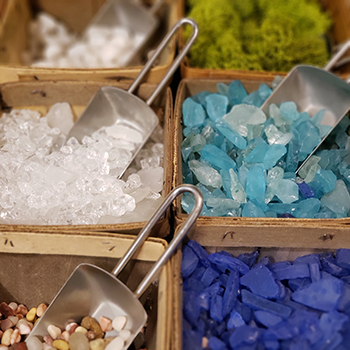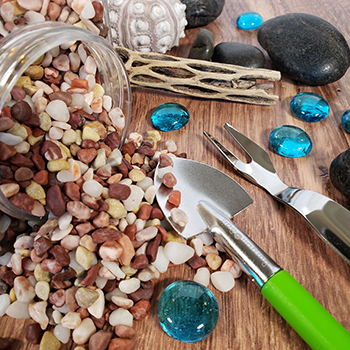We’re feeling inspired by terrariums! We have many fun items stocked up for countless ways to create your own beautiful indoor terrarium to enjoy in your home, or pass along as a personalized living gift for someone special.
Terrarium ingredients:
- Glass Container
- Substrate- Black Gold cactus mix recommended for good drainage
- Gravel or rocks
- Activated Charcoal
- Moss, coir fiber, lichen, etc.
- Small plant starts
- Personal touches- wood pieces, special stones, shells, statues, etc.
- Tools for planting and cleaning- chopsticks, tongs, paintbrush, scoop or spoon, straw
Planting your terrarium:
Step 1: Create a bottom layer of gravel in your terrarium to keep excess moisture from accumulating and pooling beneath your plant roots.
Step 2: Sprinkle some activated charcoal over the gravel. Charcoal will help control pathogens, and also absorbs and releases water at a staggered rate.
Step 3: Add your substrate as the next layer. Cactus mix is formulated to provide good drainage and will not hang on to excess moisture, which is key in a closed environment that will be more humid. Terrariums are partially or fully enclosed, so it is important to keep an eye on the humidity, especially depending on the type of plant you want to thrive, to avoid any rot. Another great way to provide good drainage for your plants is to create a unique topography with little mounds and hills.
Step 4: Select and place your plants in a desired location. Create a lovely landscape using different textures and heights to create an attractive asymmetrical look. Or if you prefer, create perfect symmetry! Air plants are a great way to build a soil free terrarium, and require little maintenance.
Step 5: Place fun or personal items in your terrarium with your plants. Beautiful rocks and stones that you treasure, shells, little pieces of wood. Create a fairy garden with tiny fencing, little statues…whatever your imagination can come up with! There are endless ways to customize and create a beautiful living scene to gaze upon, or to gift to a special person.
Step 6: Chopsticks, or thin tongs can go a long way in carefully placing items into your terrarium. A spoon can make a good mini shovel. Straws can be used for watering, as attempting to use a watering can may create a disaster in your carefully constructed terrarium.
Step 7: Take a small piece of masking tape, and mark the date you last watered your terrarium and place somewhere inconspicuous as a care reference. Place your terrarium in a well lit, preferably a location with indirect light. Direct bright light shining through glass runs the risk of cooking your plants.
Step 8: Be creative and have fun!







